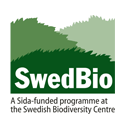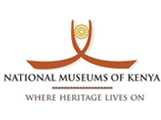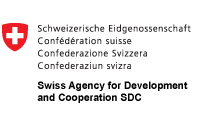Scientific Classification
Species in the Genus
Species in Kenya, Tanzania & Uganda
Description
Possible Causes of Confusion
Distribution in Kenya, Tanzania & Uganda
Habitats
Nesting
Crops Visited
Other Plants Visited
Economic / Ecological Importance
Threats
Conservation and Management Practices
Legislation (National and International)
References
Editors
Acknowledgements
Contact
Click on images to enlarge
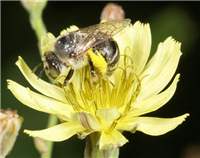
Macrogalea candida. © Bernhard Jacobi
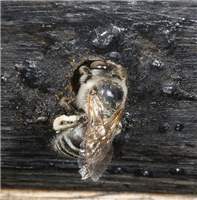
Macrogalea candida. © Bernhard Jacobi
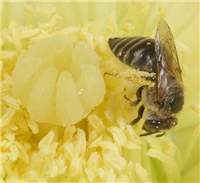
Macrogalea candida. © Bernhard Jacobi
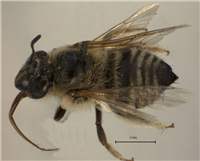
Macrogalea candida (female) - pinned specimen. Photo: Connal Eardley

Macrogalea candida (male) - pinned specimen. Photo: Connal Eardley
Summary
Honey bees are not the only bee species that are significant for human wellbeing. Macrogalea bees are a group of native bee species that do not produce honey but are likely to be important pollinators of crops and wild plants. Females have a sting, but they are not aggressive and will only sting if handled. These hairy, medium sized, long-tongued bees are only found in sub-Sahara
From a conservation and agricultural standpoint it is not necessary to recognise all the different bee genera. However, it is important to know that there is a large bee biodiversity. Different bee genera pollinate different plant species, although there is some overlap that acts as a buffer as bee populations wax and wane. For healthy ecosystems, including agro-ecosystems both diversity and abundance in the bee fauna is important.
Common Name (Language)
Small carpenter bee (English). Bees of the tribe Allodapini share this common name with bees in the genus Ceratina
Scientific Classification
Kingdom: Animalia
Phylum: Arthropoda
Class: Insecta
Order: Hymenoptera
Family: Apidae
Subfamily: Xylocopinae
Tribe: Allodapini
Genus: Macrogalea Cockerell, 1930
Species in the Genus
Current knowledge about Macrogalea shows that bees in this genus are restricted to sub-Saharan
Species in Kenya, Tanzania & Uganda
Four species of Macrogalea have been reported from
Description
Macrogalea bees are not well known by local people (including farmers) in
Possible Causes of Confusion
Macrogalea bees could be confused with Braunsapis bees . It is possible to distinguish these bees since Macrogalea bees are hairier and slightly larger.
Distribution in Kenya, Tanzania & Uganda
There is little information about their distribution in different parts of
Habitats
Macrogalea bees can live in different ecological zones so long as these can support their nesting and food requirements.
Nesting
Macrogalea bees are solitary bees that construct their nests in soft, dead plant stems in which they bore tunnels.
Crops Visited
The authors could find no reported information on crops visited.
Other Plants Visited
Macrogalea bees are common on acacia trees.
Economic / Ecological Importance
Little information exists on the usefulness of these bees to the lives of the people in
Threats
In
Conservation and Management Practices
There are now concerted research efforts in the region to develop best practices for conservation and management of bees to enhance crop production. Theoretically, bee conservation and management is inexpensive and adopted activities can also improve the aesthetic value of the landscape. Such practices involve setting land aside (e.g. a 1-metre strip) in the farmland to host all year round food resources for the bees, as well as safer sites for nesting, mating, resting and hiding from natural enemies. During flowering, farmers should manage pesticide usage carefully to avoid poisoning flower-visiting bees. Farmers should also minimise pesticide drift from the field to adjacent areas. Laws governing registration and use of plant protection products also indirectly play a major role in the protection of pollinators. KARI (the Kenya Agricultural Research Institute) is developing protocols for mass rearing of different species of solitary bees. Any successful results from this research will be freely communicated to the public. In addition, KARI is collaborating with other stakeholders to ensure in situ conservation and management of bees for pollination purposes. Much of the work of conserving native bees will be underpinned by raising public awareness of the importance of these species.
Legislation (National and International)
There is not yet any legislation in
References
1. Eardley CD, Kuhlmann M and Pauly A. (2010) The Bee Genera and Subgenera of sub-Saharan Africa. ABC Taxa vol 7: i-vi, 138 pp. http://www.abctaxa.be/volumes/vol-7-bees.
2. Eardley CD and Urban R (2010) Catalogue of Afrotropical bees (Hymenoptera: Apoidea: Apiformes). Zootaxa, 2455: 1–548.
3. Michener, C.D. (1971) Biologies of African allodapine bees (Hymenoptera, Xylocopinae). Bulletin of the American Museum of Natural History, 145, 223–300.4. Michener, CD (1974) The Social Behavior of the Bees, Harvard University Press, pp. 307–309
4. Michener, C.D. (1975) A taxonomic study of African allodapine bees (Hymenoptera, Anthophoridae, Ceratinini). Bulletin of the American Museum of Natural History, 155, 67–240.
5. Michener CD (2007) The Bees of the world, the John Hopkins University Press, Baltimore and London, pp 913.
Editors
Théodore Munyuli, Busitema University - Uganda; Muo Kasina, Kenya Agricultural Research Institute (KARI) - Kenya; Juma Lossini, Tropical Pesticides Research Institute (TPRI) – Tanzania; John Mauremootoo, BioNET-INTERNATIONAL Secretariat – UK; Connal Eardley, Plant Protection Research Institute (PPRI) – South Africa.
Acknowledgements
We recognise the support from the Kenya Agricultural Research Institute (KARI), Tropical Pesticide Research Institute (TPRI) –
Contact
BioNET-EAFRINET regional coordinator: [email protected]





